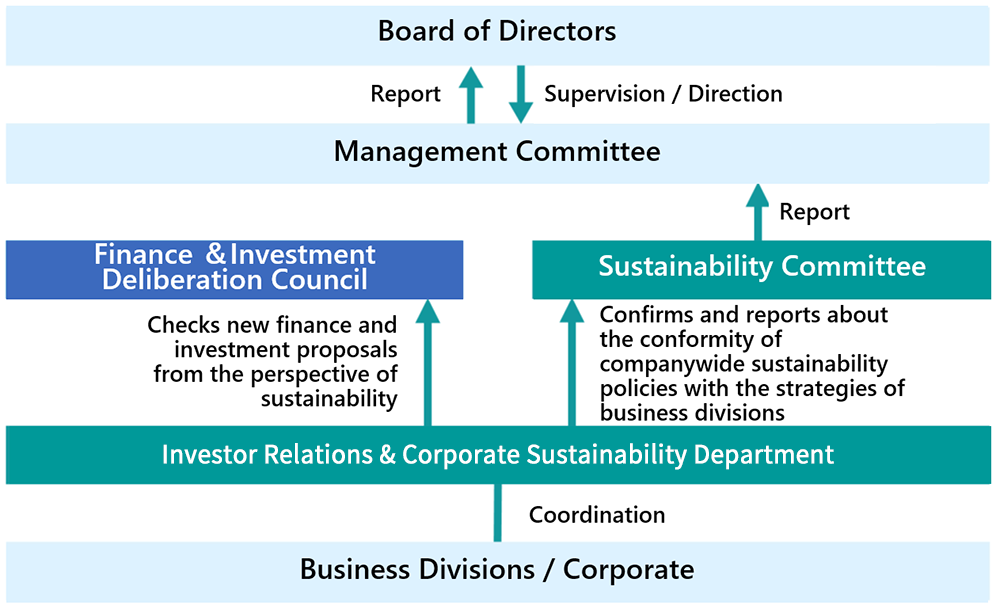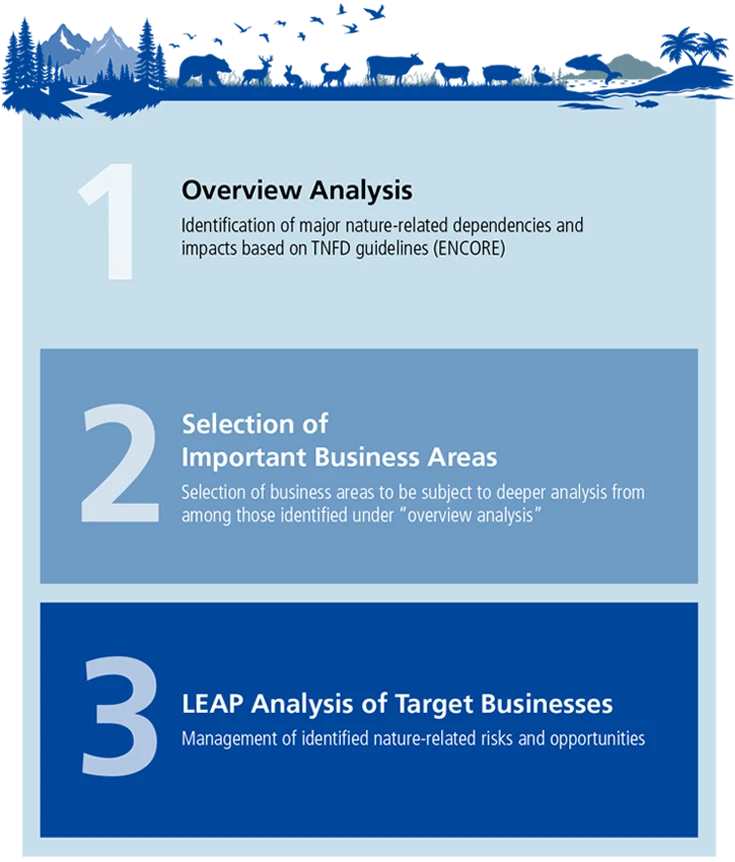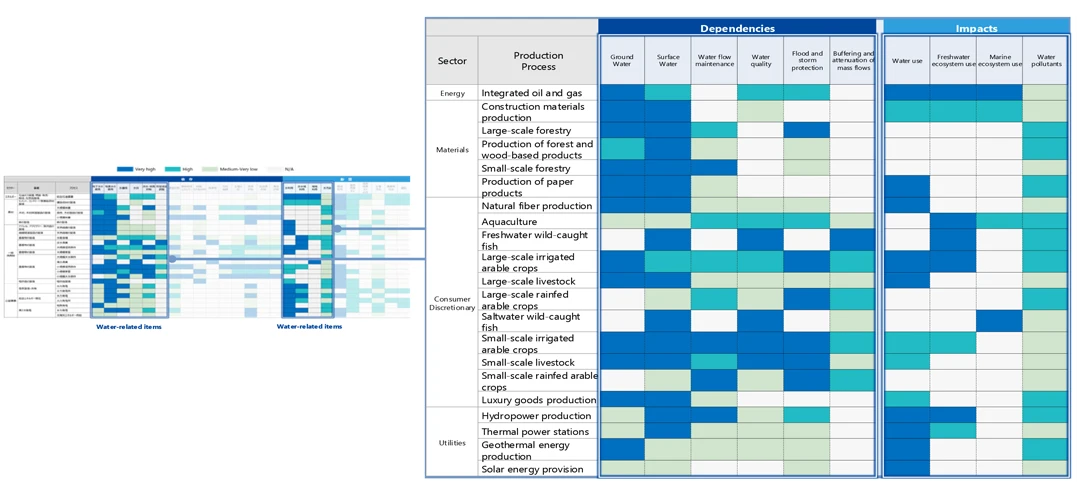Complying with TNFD
Disclosure Based on TNFD Recommendations
Disclosure Policy
Sojitz endorsed the TNFD in September 2025 and has registered as a TNFD Adopter. Sojitz Group utilizes the framework provided by the Taskforce on Nature-related Financial Disclosures (TNFD)* with the aim of actively disclosing information on nature‑related risks and opportunities.
- Taskforce on Nature‑related Financial Disclosures (TNFD): A global initiative established by organizations including the United Nations Development Programme (UNDP) as a framework for organizations to disclose nature‑related risks and opportunities to investors and the market.
General Disclosure Requirements
1. Application of Materiality
Sojitz has set focus areas including the “Environment” and “Resources” as part of its Materiality (Key Sustainability Issues) and aims to provide solutions to social issues through its business activities while reinforcing and expanding a business foundation for sustainable growth.
2. Scope of Disclosures
Disclosures cover Sojitz Corporation and major Group company locations in addition to partners across the entire value chain from upstream to downstream.
3. Location of Nature‑Related Issues
Sojitz has identified high-priority geographic areas within the value chain for the marine product business where dependence on natural capital is high.
4. Integration with Other Sustainability-Related Disclosures
Sojitz has analyzed and disclosed climate‑related risks and opportunities in line with recommendations set by the Task Force on Climate-related Financial Disclosures (TCFD). Going forward, we will further strengthen our response to nature‑related risks and opportunities, including natural capital and biodiversity, and advance disclosures aligned with TNFD recommendations. Sojitz will build on the knowledge gained through TCFD initiatives and explore the implementation of integrated disclosures that encompass both TCFD and TNFD.
5. Timeline
In Medium‑term Management Plan 2026, Sojitz will identify impacts on natural capital, including biodiversity and water resources, and consider appropriate response measures.
6. Engagement with Indigenous Peoples, Local Communities, and Affected Stakeholders
In accordance with the Sojitz Group Human Rights Policy, we recognize the importance of dialogue with Group employees, workers, and external stakeholders who are affected (or may potentially be affected) by Sojitz Group’s business activities. We engage in dialogue with stakeholders on human rights issues related to our business.
Governance
Sojitz has established a governance structure that comprises the Board of Directors, the Management Committee, and the Sustainability Committee. The Board of Directors oversees sustainability issues including nature‑related dependencies and impacts as well as risks and opportunities. The Management Committee, chaired by the president, deliberates and makes decisions on nature-related strategies and key measures. The Sustainability Committee, also chaired by the president, convenes at least four times a year to develop policies and systems to advance sustainability initiatives, identify risks and opportunities, set metrics and targets, and monitor progress. The Sustainability Committee regularly reports its activities to the Management Committee and Board of Directors.

Sojitz Group Stakeholders
Sojitz Group is engaged in a wide range of businesses globally. We have the opportunity to connect with many stakeholders through our business activities in different countries and regions around the world.
At Sojitz Group, we conduct business activities based on valued feedback from our stakeholders and place great importance on building relationships based on trust.

■ Human Rights Policy
Acting in accordance with the Sojitz Group Human Rights Policy, we are committed to respecting human rights as set out in the International Bill of Human Rights and the International Labour Organization’s (ILO) Declaration on Fundamental Principles and Rights at Work, and Sojitz conducts activities in accordance with the UN Guiding Principles on Business and Human Rights. The Sustainability Committee deliberates on policies and measures to address environmental and social risks, including human‑rights‑related risks, and implements decisions across the organization after reporting to the Management Committee and the Board of Directors. Through stakeholder dialogue, Sojitz Group carries out a process encompassing (i) policy formulation and communication, (ii) risk assessment, (iii) improvement and remedy, and (iv) disclosure of outcomes. We take prompt corrective action when risk assessments or grievance mechanisms reveal areas for improvement.
Read more
Risk and Impact Management
■ Identification and Assessment of Nature‑related Issues
We assess risk and impacts related to natural capital (biodiversity and water) at Sojitz Corporation, Group company sites, and across the supply chain from upstream to downstream. Based on TNFD guidance, we used the ENCORE tool to identify businesses with high dependencies and impacts on natural capital within our portfolio. We then applied the LEAP approach (Locate, Evaluate, Assess, Prepare) to conduct analysis of our marine products value chain, which is one of Sojitz’s key focus areas. In addition, we use the World Resources Institute’s Aqueduct tool for analyzing water-related risks to assets, such as floods and droughts.
■ Management Processes for Nature‑related Issues
The Sustainability Committee deliberates on policies to address environmental issues such as biodiversity, which are advanced under the supervision of the Board of Directors following reports to the Management Committee and the Board. We analyze and evaluate environmental and social risks, including biodiversity impacts in investment and loan deliberations, in order to confirm the strategic rationale of projects from a sustainability perspective and to resolve proposals on investment execution. The Investor Relations & Corporate Sustainability Department leads day‑to‑day implementation, executing directives from the Sustainability Committee and conducting sustainability reviews (covering biodiversity) of investment and loan proposals.
■ Integration into Enterprise Risk Management
Under our enterprise risk management (ERM) framework, the Internal Control Committee—with the president and CFO serving as members—coordinates with relevant internal committees to discuss and establish ERM policies, maintains a comprehensive view of risk, monitors risk management executed by business execution organizations (the first and second lines of risk management), and issues guidance to relevant parties. As the third line of defense, the Internal Audit Department independently verifies the risk management practices of the first and second lines. Enterprise‑level risks encompass environmental and social risks, which include natural capital. The Internal Control Committee regularly reports the status of these risks to the Management Committee, the Board of Directors, and the Audit and Supervisory Committee.
Strategy
In accordance with TNFD guidance, we have confirmed Sojitz’s nature-related dependencies and impacts following the steps outlined in the diagram below.

Identifying Businesses with High Nature related Dependencies and Impacts as Targets for Analysis
In line with TNFD guidance, we used the analytics tool ENCORE* to first confirm the dependencies and possible impacts of the average business on natural capital. As a result of this ENCORE analysis, we identified 25 businesses with high dependencies and impacts in our portfolio. For both impacts and dependencies, the company showed high overall scores in the water category out of the various ecosystem components. TNFD’s LEAP approach (Locate, Evaluate, Assess, and Prepare) was used for analysis of Sojitz’s marine products value chain, which is one of the company’s key focus areas that includes businesses such as Sojitz Tuna Farm Takashima and marine product processer TRY Inc.
- ENCORE (Exploring Natural Capital Opportunities, Risk and Exposure):
An analysis tool to help private enterprises understand the magnitude of their nature-related dependencies and impacts, which was jointly developed by the UN Environment Programme (UNEP) and The Natural Capital Finance Alliance (NCFA).
■ ENCORE Analysis of Sojitz’s Business Portfolio

LEAP Analysis of Our Marine Products Value Chain
Locate: Identify the organization’s interface with nature
We identified priority areas with a significant risk of diminishing biodiversity or ecosystem service quality and the regional characteristics of these targets including Sojitz Tuna Farm Takashima’s in-house aquaculture, upstream feeding, and fry procurement, as well as TRY Inc. and Marine Foods’ domestic processing practices.

Evaluate: Assess dependencies and impacts on nature
We identified risk factors and points for analysis in priority regions identified through the Locate step. Nature-related conditions and regulations were investigated at Sojitz Tuna Farm Takashima, and meetings with each company were held to gain a better understanding based on identified risk factors and analysis.
Assess: Determine nature-related risks and opportunities
We identified risks and opportunities based on the findings of earlier LEAP steps in accordance with TNFD’s sector-specific guidelines. The high-priority risks and opportunities for Sojitz Group’s initiatives are compiled below.
| Major Projected Risks and Opportunities | Sojitz Group Initiatives | |
|---|---|---|
| Risks | • Decline in product quality or increased death rates at farms due to rising ocean temperatures or red tides • Ecosystem degradation or economic impacts due to fish escaping from aquaculture cages • Changes in optimal farming locations due to water pollution from uneaten feed |
• Utilization of Integrated Biodiversity Assessment Tool (IBAT)* to survey surrounding areas • Collection and analysis of water temperature, sodium content, and other data • Development of red tide forecasting app • Use of AI technologies for counting tuna • Regular inspections of aquaculture cages • Optimization of feed amounts and shipment timings |
| Opportunities | • Investment in technologies for reducing impacts on ecosystems |
- Integrated Biodiversity Assessment Tool (IBAT):
A tool that provides geospatial data and access to databases including the International Union for Conservation of Nature Red List of Threatened Species, World Database on Protected Areas (WDPA), and World Database of Key Biodiversity Areas (WDKBA).
Prepare: Develop responses to these risks and opportunities and prepare for reporting
Sojitz Tuna Farm Takashima is actively introducing ICT technologies into its operations and working with the Japan Agency for Marine Earth Science and Technology (JAMSTEC) through an industry-academia partnership for the establishment of a smart farming system. In addition, Sojitz Tuna Farm Takashima has begun work on the development and verification of a red tide forecasting app in collaboration with Kyushu University. Sojitz provides this technology not only to Sojitz Tuna Farm Takashima, but also to other aquaculture businesses in order to offer farming solutions and protect sustainable marine resources.
Read more
Insights gained through LEAP analysis will be applied in the operation of individual businesses. Moving forward, the scope of analysis will be expanded to include upstream feed and fry procurement as well as downstream processing at TRY and Marine Foods. Sojitz will continue to monitor and identify natural capital-related dependencies and impacts for biodiversity and water risks across its business portfolio.
Environmental Protection and Social Contribution Initiatives in Mine Development and Operating Businesses
In the development and operation of upstream resources such as mines, Sojitz Group utilizes proper environmental and social impact assessments to accurately evaluate potential damage to natural capital and impacts to ecosystems. We formulate business plans with mine management and monitoring plans, including plans for mine closures. Sojitz is committed to ensuring its business activities are in compliance with national and local laws and regulations and that the company obtains all necessary permits and licenses to give due consideration to environmental protection.
In the mine development stage, we seek to minimize impacts to biodiversity in designated regions by taking steps to reduce our environmental impact during the process. After transitioning to the operational stage, we conduct river relocation work to maintain waterflow to the mining area, conduct regular environmental impact monitoring, and implement preventative measures to mitigate risks in the event of an emergency. We carry out the necessary rehabilitation activities and other maintenance measures for all mines, both while in operation and during the mine closure process, to prevent the occurrence or expansion of damage-related risks to natural capital, reduce environmental impact, and promote environmental conservation.
At Sojitz’s open-cut coal mines in Australia such as Gregory Crinum and Meteor Downs South, we keep the topsoil that is removed for mining and use it after mining is completed to cover up the mined area. We then work to restore the land to its original condition by planting new native vegetation as part of the reclamation process. In addition, Sojitz secures habitats both on-site and in part of the surrounding area for rare flora and fauna such as squatter pigeons that could potentially be affected by mining activities. Sojitz conducts all conservation activities in accordance with related laws and regulations and in line with approved conservation plans.
Wood Procurement Policy Initiatives
Sojitz Group conducts business with approximately 1,500 wood-related suppliers. We select and conduct targeted wood surveys for over 80% of our total purchased wood supply using criteria that includes the supplier’s country risk level, the amount of wood purchased in terms of monetary value, and suppliers’ compliance with Sojitz Group policies. Surveys are conducted to access wood traceability and environmental and social considerations, and we also spread awareness of the Group’s policies among our business partners.
Read more
Sojitz and applicable Sojitz Group companies have acquired certification from the Forest Stewardship Council (FSC), an NGO that certifies sustainable forest management, and we are committed to sustainable forest resource procurement practices.
Read more
Indicators and Targets
We are committed to minimizing environmental impacts associated with our business activities in accordance with the Sojitz Group Environmental Policy established in 2004. Through initiatives to reduce CO₂ and other greenhouse gas emissions, Sojitz aims to combat climate change and address impacts to biodiversity. We have set the following indicators and targets as specified below.
Read more
